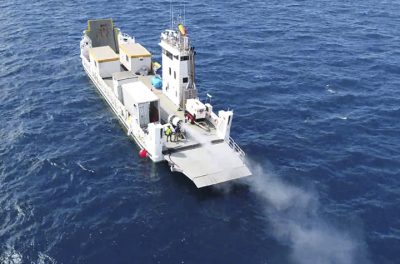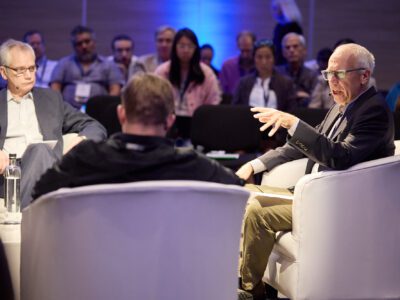A Solar Geoengineering Milestone Goes Largely Unnoticed
The first explicit, meaningful outdoor test garnered little attention in the news or from environmentalists
In response to insufficient cuts in greenhouse gas emission, some scientists and others are researching solar geoengineering. These techniques would reflect a small portion of incoming sunlight to cool the planet and counter climate change. A major step in solar geoengineering was recently taken, although you probably wouldn’t know it from reading the news or following environmental groups.
While solar geoengineering has been the subject of quite some modeling work for well over a decade, a central question has been, “When will meaningful outdoor experiments take place?” One could point to a low-altitude test of aerosols in Russia in 2009, but its substantive value seems limited. And while a 2011 experiment that examined the interactions among aerosols, clouds, and solar radiation was important for the proposed “marine cloud brightening” method of solar geoengineering, it was only later acknowledged as such. What would have been the first explicit and meaningful outdoor solar geoengineering field test was cancelled in 2012 due to irregularities and potential conflict of interest in the review process.
Regardless, the eyes of the interested and concerned have long been on Harvard’s Solar Geoengineering Research Program, which has been planning an outdoor test since about 2012. In 2018, Nature news reported:
If all goes as planned, the Harvard team will be the first in the world to move solar geoengineering out of the lab and into the stratosphere, with a project called the Stratospheric Controlled Perturbation Experiment (SCoPEx)….
the experiment will be the first to fly under the banner of solar geoengineering. And so it is under intense scrutiny, including from some environmental groups, who say such efforts are a dangerous distraction from addressing the only permanent solution to climate change: reducing greenhouse-gas emissions…
“SCoPEx is the first out of the gate, and it is triggering an important conversation about what independent guidance, advice and oversight should look like,” says Peter Frumhoff, chief climate scientist at the Union of Concerned Scientists in Cambridge, Massachusetts, and a member of an independent panel that has been charged with selecting the head of the advisory committee. “Getting it done right is far more important than getting it done quickly.”
As noted, skeptical environmentalists and scientists are concerned about SCoPEx, not because of the direct physical risks — which they acknowledge would be negligible — but largely because of its symbolism. For example, one critical climate scientist calls it “cross[ing] the Rubicon.” As such, they and others call for additional governance of solar geoengineering research.
Indeed, SCoPEx has been investing in ex ante governance. One of its objectives is “To perform the experiments in a manner that exemplifies good governance by developing and implementing norms, mechanisms and practices that can serve as useful templates for possible future solar geoengineering field experiments.” To this end, in 2018 its leadership decided to form an independent Advisory Committee. This necessitated a search committee the dean’s approval. The Advisory Committee was constituted last year.
In March, “the first [experiment] to fly under the banner of solar geoengineering” took place… in Australia. A couple years ago, the Queensland government awarded a few modest grants to protect the Great Barrier Reef, including to two groups that wished to research solar geoengineering for this purpose. One looked at an ultra-thin biodegradable reflective film for the ocean’s surface and the other at brightening marine clouds. The latter project, based at Sydney Institute of Marine Science and Southern Cross University, began its outdoors work, just before the coronavirus regulations came into effect. The federal Australian government subsequently awarded the team an additional grant to continue its efforts.
There are two clear contrasts between Harvard’s SCoPEx and the Queensland marine cloud brightening project. For one thing, the former has (publicly) emphasized governance. Additional measures, such as establishing an independent Advisory Committee and greater public communications, have contributed to the project’s extended timeline. On the other hand, the latter went from grant to field test in less than two years. I am unaware of any additional dedicated governance measures there. The Queensland-funded team consists only of engineers and scientists, with no social scientists or humanities scholars. And the only public information was a paragraph from the Queensland government (removed within a year) and a minimal website.
For another thing, the Harvard project has generated abundant media coverage and attention from critical environmental activist groups. When it goes forward, I expect another large round of this. In contrast, the Great Barrier Reef experiment went forward almost silently. I found balanced news pieces from only Reuters, AFP, and The Guardian — which typically never misses a chance to excoriate solar geoengineering and SCOpEx specifically. The skeptical environmental groups have been noticeably silent.

Why such a difference in attention, critical and otherwise? Perhaps “injecting chemicals into the stratosphere” is more foreboding than “spraying some seawater into the air.” Maybe a mostly privately funded project at the American-based Harvard University is an easier target from the left than a publicly supported one at a couple modest research institutions Down Under. SCoPEx’s scientific objective is to improve the understanding and efficacy of stratospheric aerosol injection in general, whereas the marine cloud brightening one is specifically geared toward protecting the Great Barrier Reef, an environmental icon. Or the latter project could have simply “flown under the radar.”
Regardless, as a scholar of geoengineering governance, I am curious about the impact on decision-making. I generally support some dedicated governance of large-scale solar geoengineering activities. (For example, host institutions could have standing independent boards to review outdoor experiments, and a societal dialogue about the wider endeavor is warranted.) However, I am fairly sanguine about the seeming lack of dedicated governance in Queensland. I believe neither that the public needed to have a significant participatory role in this experiment, that the project is hurling us down the slippery slope of inevitably using solar geoengineering, nor that it was necessarily done “quickly” instead of “done right.”
I look forward to the resulting publications.
Update (May 8): On Twitter, journalist James Temple pointed out that the coronavirus is an important reason that the Australian marine cloud brightening experiment received little attention in the news media. That’s a valid point, although the project had been in the works for 2 years. (I’ll note that James was one of the few to write on it during that time span.) And I am unsure of the extent to which the pandemic is occupying the attention of critical environmental organizations. Duncan McLaren also suggests that “It’s also framed as a local response to a local problem.”
Second update (May 13): The anti-technology ETC Group released a statement on the marine cloud brightening experiment. I responded on Twitter (compiled for clarity):
The ETC Group claimed that the recent small outdoor test of marine cloud brightening solar #geoengineering “defied an international moratorium on the deployment of geoengineering technologies”. That is false. ETC referred to a 2010 decision by the Conference of Parties to the Convention on Biological Diversity. It is not a moratorium but, in the words of CBD’s own report [PDF], “a comprehensive non-binding normative framework.” Furthermore, the CBD COP does not have the authority to issue binding rules, and the decision merely “Invites Parties… according to national circumstances and priorities… to consider the guidance”. ETC Group misquotes the decision, notably omitting the qualifier “geo-engineering activities that may affect biodiversity take place” from the CBD COP decision. As far as I can tell, the Australian outdoor test did not affect biodiversity. In fact, in 2016 the CBD COP called for “more transdisciplinary research and sharing of knowledge among appropriate institutions… to better understand the impacts of climate-related geoengineering on biodiversity and ecosystem functions and services.”
To top it off, ETC Group claims, again falsely, that “Fossil fuel companies have been funding research into solar geoengineering for decades.” This is simply not true.
P.S. the claim that outdoor solar geoengineering activities are subject to a prohibition or moratorium was one of the “Five solar geoengineering tropes that have outstayed their welcome” that @peteirvine Andy Parker and I put forth in 2016.
In addition, several scholars of the Australian Forum for Climate Intervention Governance wrote an in-depth blog post that adds important local details, concluding that “this experiment…. provides an example of outdoor experimentation proceeding under existing domestic laws, on the understanding that governance will be developed as part of a broader GBR intervention framework.” They suggest the lack of attention was because it was geared toward protecting a “nationally-iconic area,” there was “early governance and community engagement,” “Australia has a long history of terrestrial cloud seeding,” and the public was “focused on other issues.”
Reader Comments
8 Replies to “A Solar Geoengineering Milestone Goes Largely Unnoticed”
Comments are closed.







Supposedly I receive updates from the Harvard project, but rarely hear from them. I though your article was an update. If you have suggestions for better governance, make them. Your article is pretty thin.
My writings on the governance of solar geoengineering (and more), including a book, are available at my website http://jreynolds.org/publications/
All you have to do is look at the sky every day in Florida and you can see we are way beyond what is printed in this piece. Chemtrails criss cross and fill the sky. What you fail to inform your readers is all that aluminum oxide eventually falls back to earth and contaminates the soil and water supply and we inhale it. Numerous peer reviewed studies have show a correlation between elevated levels of aluminium in the brain tissue and blood of Alzheimer and patients that suffer from dementia.
Events as early as 1996 directly related to geoengineering or weather warfare are well documented but has never been acknowledged.There might be hope after all if enough awareness is generated to stop these operations for the sake of all creation and our posterity.
This article is disinformation and outright lies. Disgusting. Active GLOBAL GEOENGINEERING HAS BEEN DEPLOYED FOR 20 YEARS MINIMUM. So….the author of this article is either incompetent or is an agent of the forces in bed with this whole agenda.
This article is complete disinformation, you should be ashamed of yourself for being involved in the covert Geoenginering that has been going on for decades now!
Hi Jessie,
I had been waiting for a long time to hear more details and analysis on the geoengineering project in Austraila, thank you for your article.
Thanks for your many years of hard work on this topic. I dream for the day when instead of opening with:
In response to insufficient cuts in greenhouse gas emission, some scientists and others are researching solar…
You open
In response to insufficient cooling created by the Corona Emissions Cuts, and their massive reduction in aerosol shading, scientists and others are researching solar…
We need you to hammer home the reason emissions reductions wont work, not because we aren’t cutting enough. Emissions reductions won’t work because we still need the aerosol shading.
I believe it’s time to spray the poles back froze, so everyday I hope to see the next development from SCoPEx myself, for one because it seems more fair to everyone since it spreads quickly and easily to an even layer….
Change my mind 😉
Scopex Really needs to move out.We have already waited too long to get the technical knowledge We need to decide how to proceed on solar radiation management